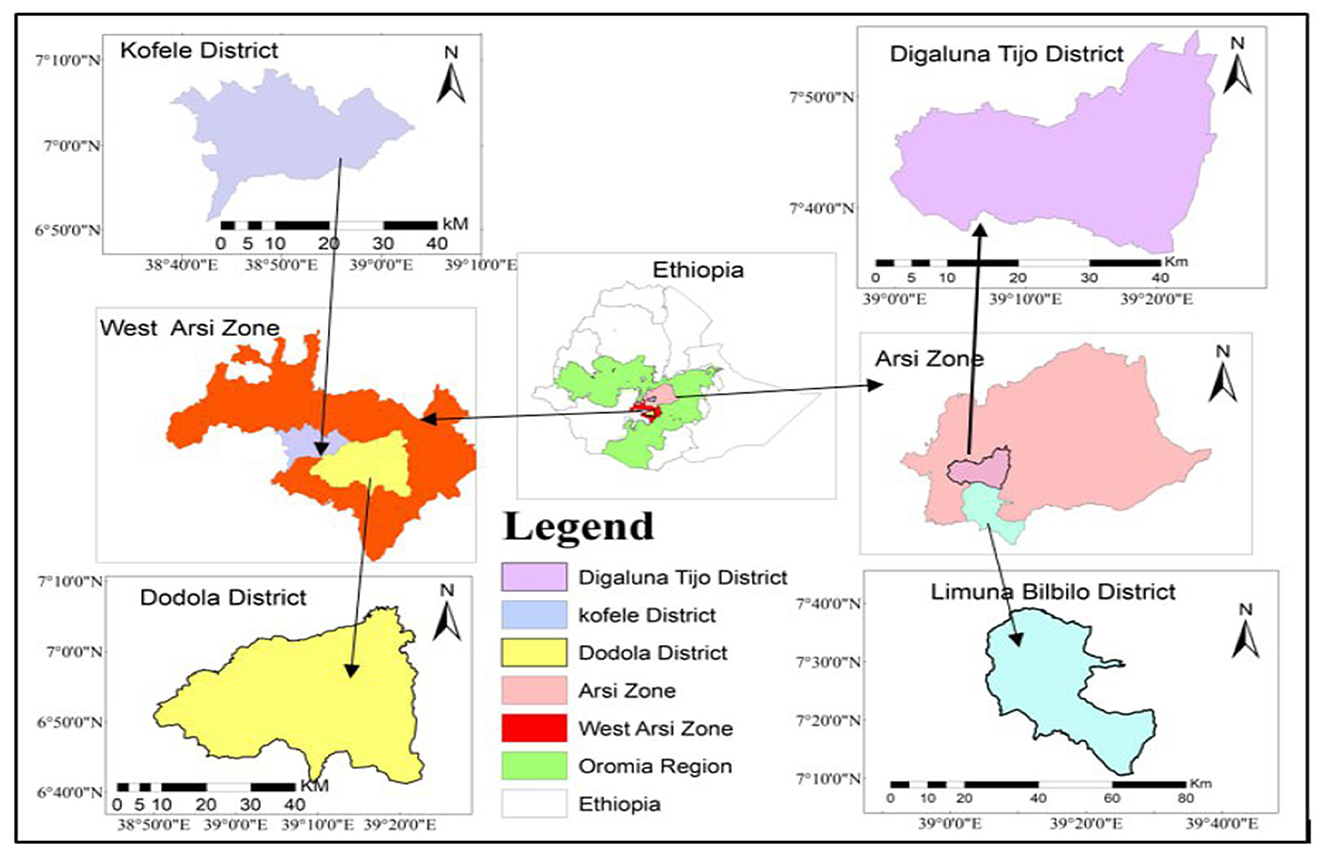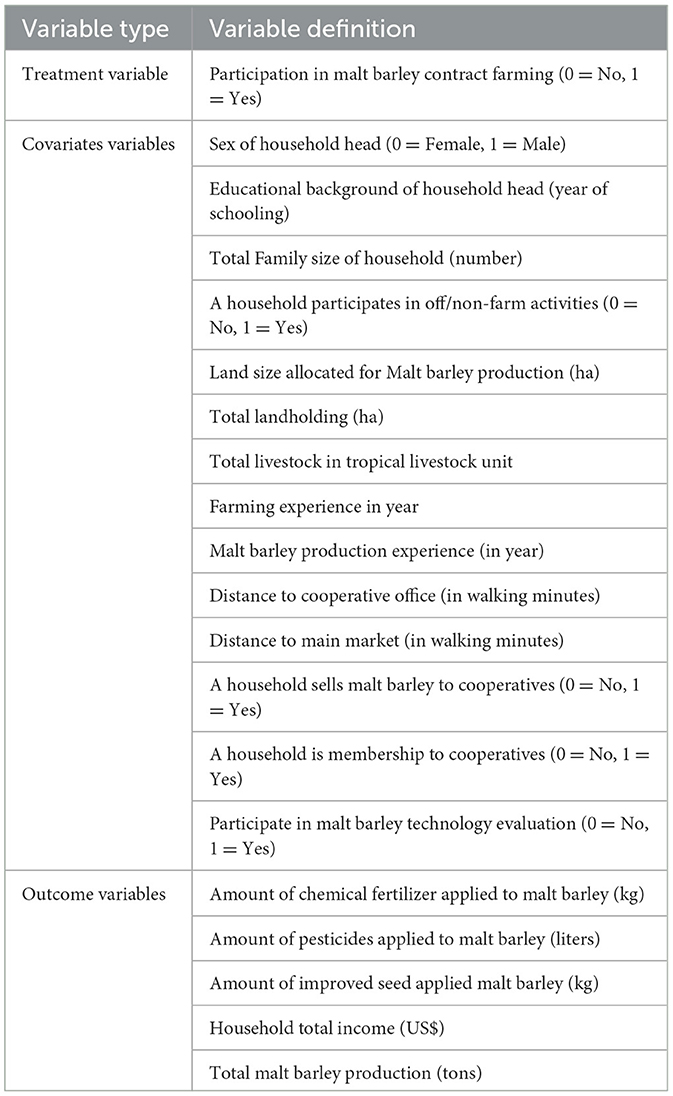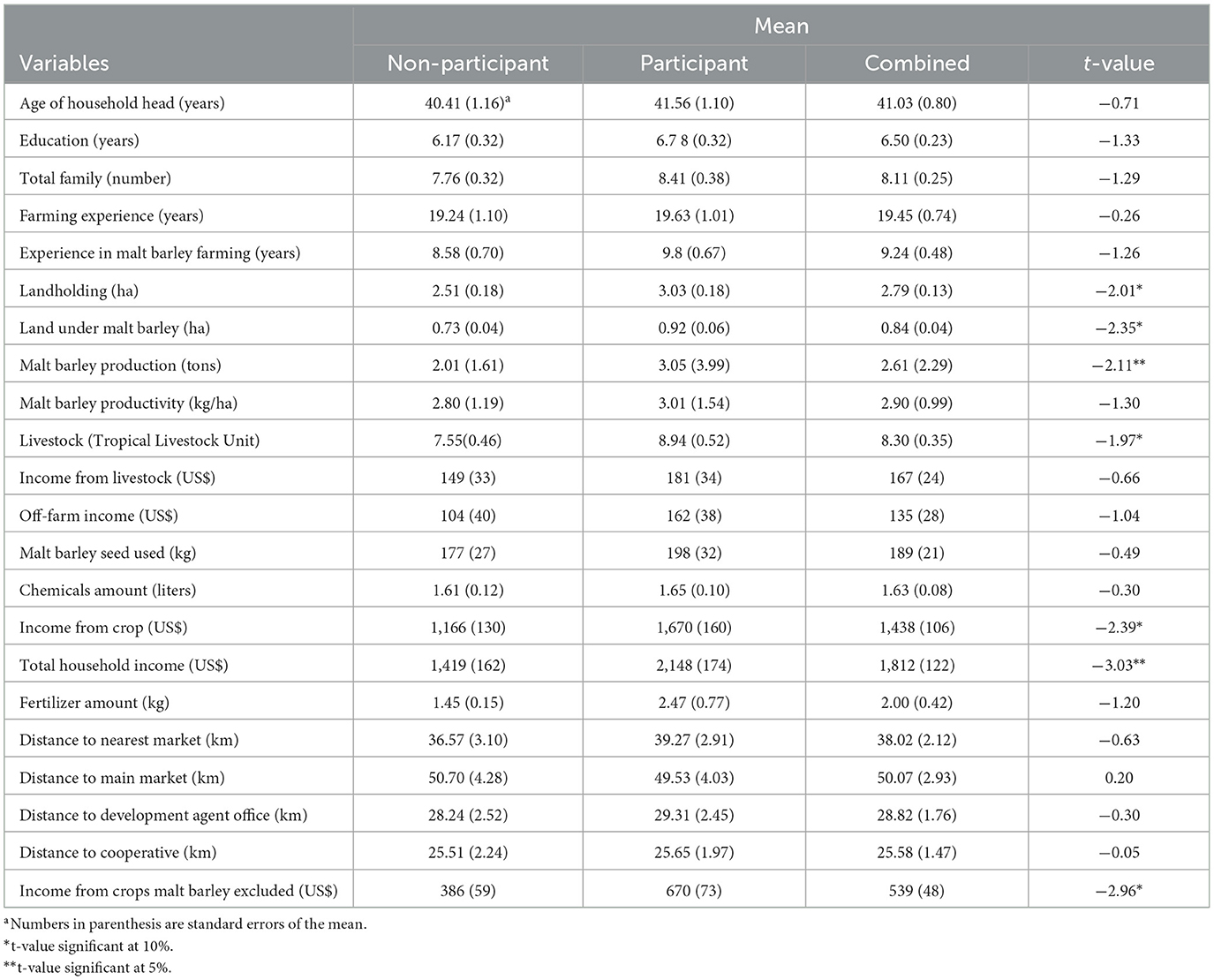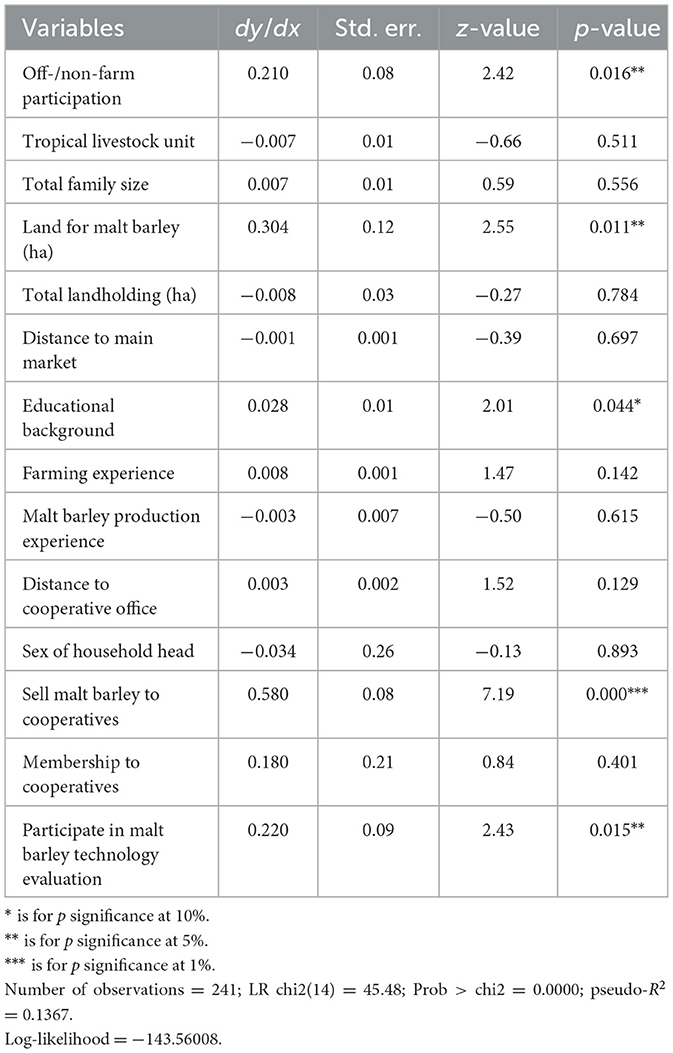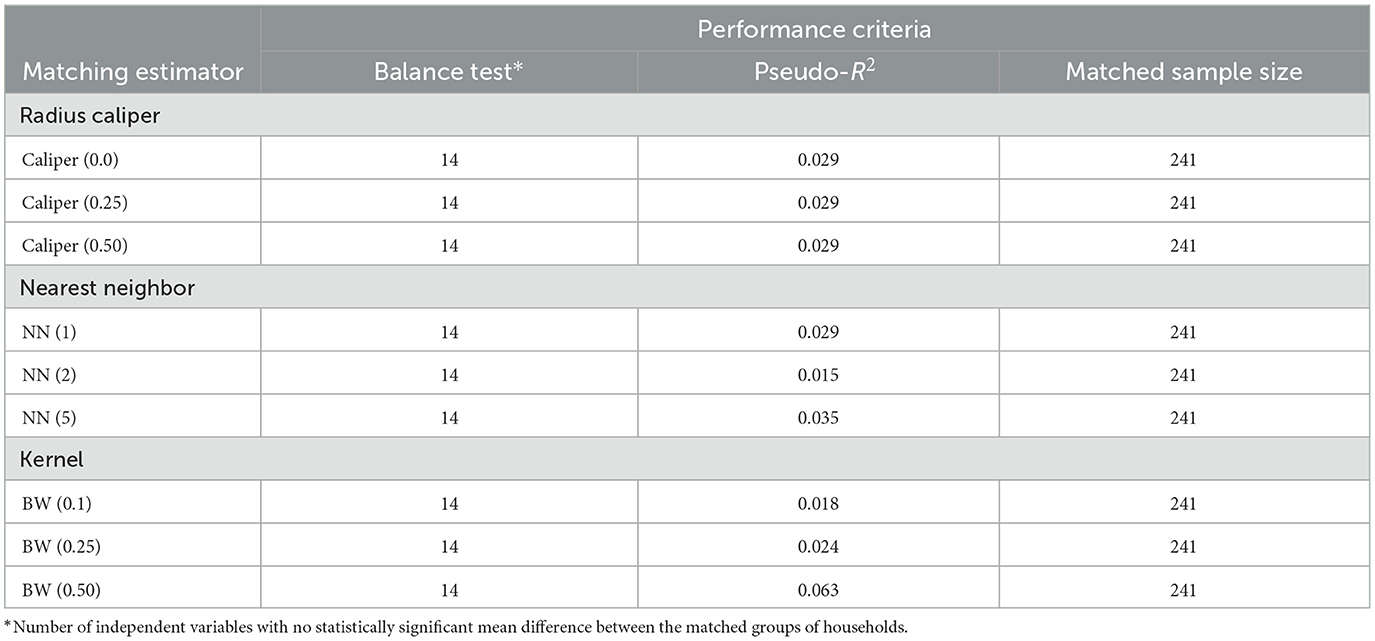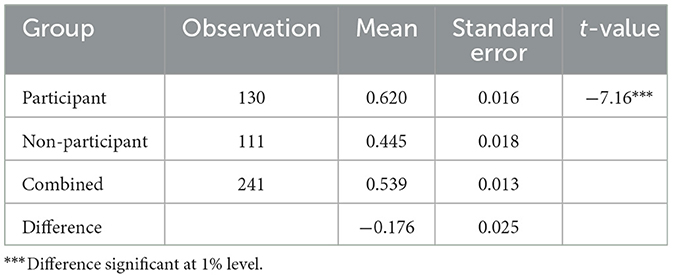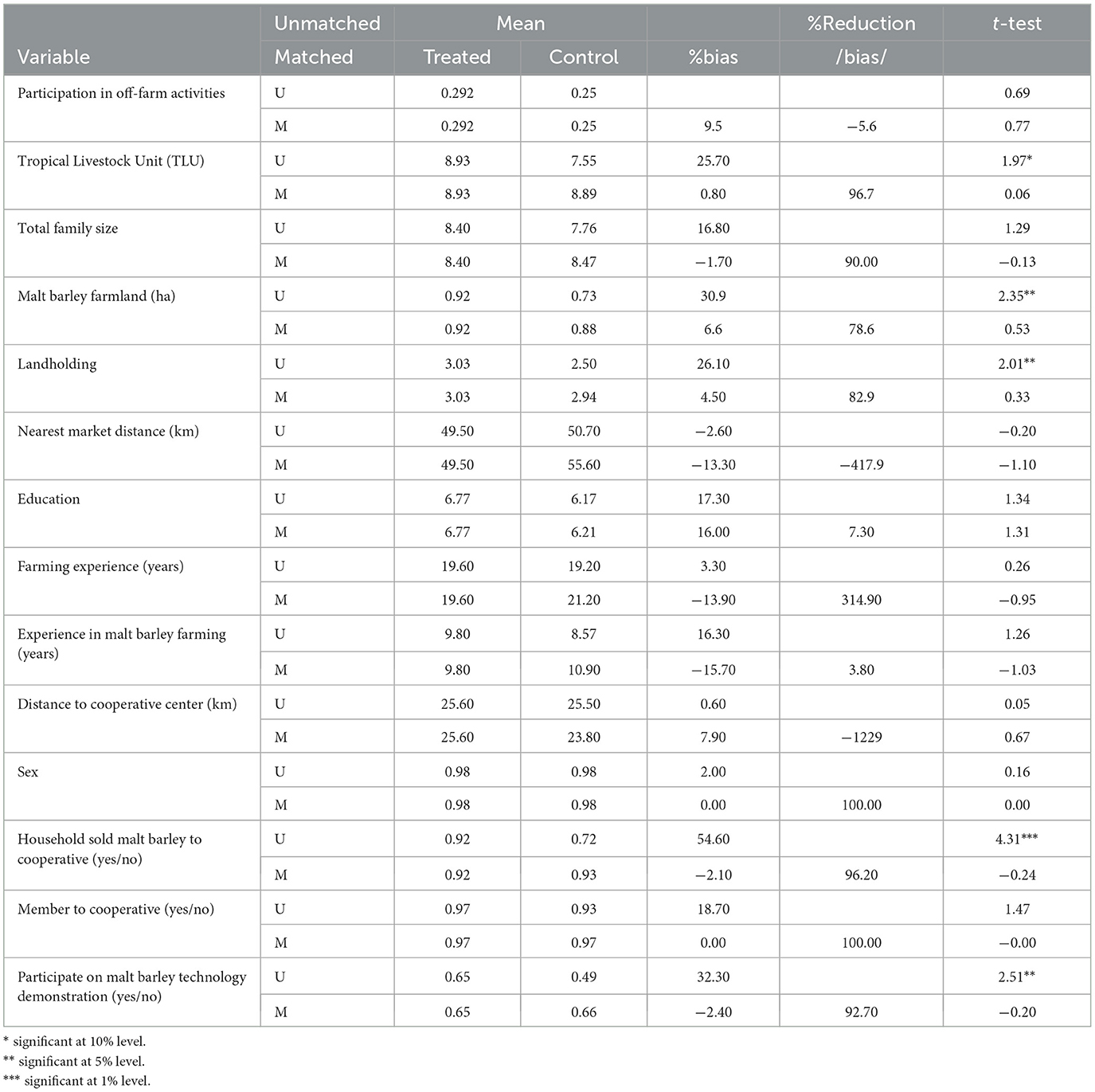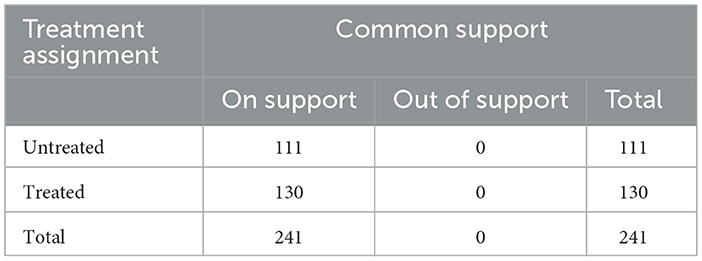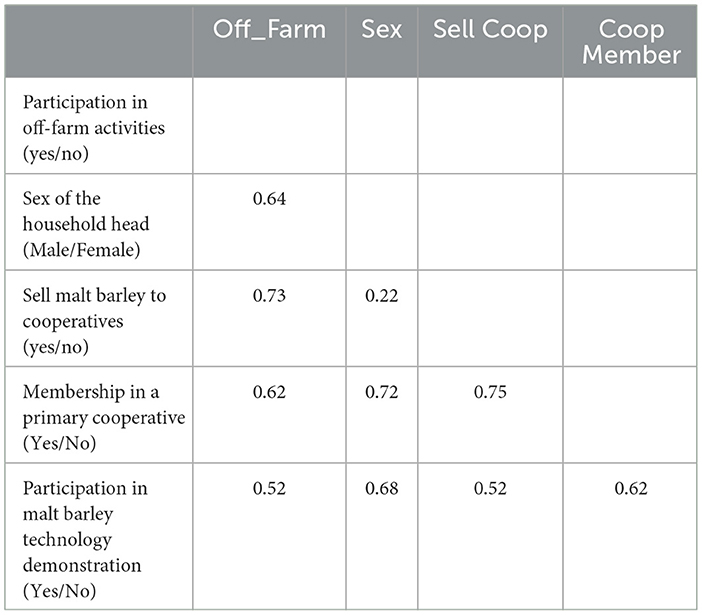- 1Socioeconomics Research Directorate, Oromia Agricultural Research Institute, Asella, Ethiopia
- 2Department of Integrative Agriculture, College of Agriculture and Veterinary Medicine, United Arab Emirates University (UAEU), Al Ain, United Arab Emirates
Introduction: Contract farming (CF) is an agreement between farmers and processing and/or marketing firms for the production and supply of agricultural products under forward agreements, frequently at predetermined prices. Malt barley–producing smallholder farmers in Ethiopia are engaged in CF with different malt factories and breweries in the Arsi and West Arsi zones. However, factors affecting participation in CF and its impact on households' welfare and input use have not been well studied so far.
Methods: We address this gap by first describing the CF models practiced in the study area. Subsequently, we identify the factors that induce farmers to participate in CF and estimate the impact of participation in CF on households' income, intensification, and land productivity. For that purpose, the barley-producing households were clustered as participants and non-participants in CF. Household-level data from 248 randomly sampled households were collected by face-to-face interviews using a structured questionnaire. In addition, focus group discussions (FGDs), key informant interviews (KIIs), and secondary data were used to substantiate the household-level data. Finally, narrative summaries and propensity score matching were used for data analysis and interpretation.
Results and discussion: The FGD and KII results showed that smallholders tend to participate in intermediary and resource-providing CF types. Malt barley producers' participation in these CF schemes proved to be positively correlated with education level, land size allocated to malt barley, participation in crop output marketing, and household income. The average treatment effect on treated results showed that CF participant households generated US$744.63 1 more than non-participants. Malt barley CF participation also led to increased fertilizer application per household, resulting in increased malt barley production. The results confirm that CF participation can raise yields as well as household income thanks also to better direct connections between producers and agribusinesses (such as breweries and malt mills). It is therefore essential for policymakers and practitioners to support these linkages and establish additional platforms for interaction.
1 Introduction
The concept of contract farming (CF) can be defined as an agreement between farmers and processing and/or marketing firms for producing and supplying agricultural products under forward agreements, frequently at predetermined prices (Eaton and Shepherd, 2001; Otsuka et al., 2016). According to The Food and Agriculture Organization of the United Nations, CF is also defined as “agricultural production carried out according to a (formal) contract between a purchaser and farmer which establishes conditions for the production and marketing of a farm product or products” (Pultrone and Silva, 2012). The arrangement often involves the purchaser providing a degree of production support by, for example, supplying inputs and providing technical advice. It is a form of vertical coordination whereby agribusiness firms contract farmers to produce for distant markets or grow raw materials for their processing facilities under various conditions (Prowse, 2012). A fundamental feature of CF is the shifting of risk from producers to processors because it is a form of the futures market (Rehber, 2018). These conditions might include providing seeds, other inputs, credit, and technical services to smallholders while guaranteeing supply to the agribusiness firm. It is a mechanism by which agribusinesses replace or supplement primary agricultural production with supply from smallholders (Glover and Kusterer, 2016).
Because globalization, population growth, and rural infrastructure expansion have created new markets for high-value commodities, certified crops, and animal production, CF has been utilized in both developed and developing countries (Ncube, 2020). CF is being promoted by numerous nations, including those in Africa and Latin America, as well as China and India. For instance, in Vietnam, 90% of cotton and fresh milk production, 50% of tea production, and 40% of rice production all occur within the CF system, whereas in Brazil, 75% of chicken selling occurs under the CF system (Setboonsarng, 2008).
This farming technique benefits both agribusiness (buyers) and agricultural producers, particularly smallholders (Ncube, 2020). Contractual agreements enable smallholders to access more profitable regional and worldwide markets, as well as inputs, technology, and extension services. According to studies, smallholders who participate in CF initiatives report revenue increases of up to 44% (Briones and Galang, 2014). The contract sourcing of agricultural products provides buyer enterprises with flexibility in annual procurement, a reliable supply source of consistent quality, and a decrease in the risks associated with direct production investment. CF, viewed as a means for connecting smallholder farmers and markets, is thought to solve a fundamental impediment, shifting agriculture in developing countries from subsistence farming to market-driven (Khalfan, 2012). However, it is not without complications.
Some proponents, particularly international development agencies like the World Bank, view CF as a win–win arrangement—an efficient mechanism for reducing market failure and generating mutual benefits for both parties involved (Oya, 2012). In contrast, critics aligned with the “Food First” perspective consider CF a win–lose arrangement. They highlight the vulnerability and powerlessness of smallholder farmers within such contractual relationships. Many CF schemes reveal significant disparities in pricing information between farmers and firms. Additionally, the high cost of inputs can trap smallholders in debt, locking them into contracts they may not be able to exit. The Food First school also argues that CF facilitates the spread of cash crops at the expense of food security (Barrett et al., 2010).
Yassin (2014) offers further insights into this debate, which intersects with broader concerns such as “land grabbing”—the acquisition of land by external investors. Some view CF as a tool for modernizing agriculture in an inclusive and equitable way (Deininger and Byerlee, 2011; Cotula et al., 2009; World Bank, 2007). Others, however, emphasize the structurally weak position of smallholders and regard CF as only marginally better than land grabbing (Ochieng, 2009; Chasukwa, 2013). In Ethiopia, although this debate remains highly relevant, CF arrangements continue to receive strong policy support and are actively promoted.
According to the U.S. Department of Agriculture estimates in September 2022 World Agricultural Production (2022) and AtlasBig.com (2022), Ethiopia is the largest barley producer in Africa and 17th in the world. In Ethiopia, the number of smallholder farmers producing barley, the size of land allocated for barley production, and the total amount of barley produced are increasing from time to time. For instance, the CSA (Central Statistics Agency) (2015) and CSA (The Federal Democratic Republic of Ethiopia Central Statistical Agency) (2014a,b) evidence these increments. However, land allocation and barley production decreased by 2.59 and 1.64%, respectively, while yield increased by approximately 1% between 2019 and 2020 (CSA (The Federal Democratic Republic of Ethiopia Central Statistical Agency), 2021). However, malting barley makes up approximately 10% of all barley production, and although the nation exports some food barley, the quantity of malting barley is insufficient (Alemu et al., 2014), and the gap, an increasing deficiency, for malting barley is being fulfilled by import. For instance, in 1994, the net import bill for malting barley was US$240,000; in 2014, it increased to US$40 million, and if this trend continues, it will increase to US$240 million in 2025 (Rashid et al., 2019).
In contrast to food barley, of which approximately 80% is consumed at the household level, approximately 70%−80% of malting barley production is sold. Malting barley is predominantly cultivated as a cash crop, making market access critically important. In Ethiopia, the government has initiated CF arrangements through the Agricultural Transformation Agency with multiple objectives. Unlike other countries, where meeting quality standards is often the primary concern (e.g., WBG (The World Bank Group), 2018, in the case of Uganda), Ethiopia's approach is more production-driven.
The government invited two of the world's largest breweries to establish operations in the country. However, the current domestic production of brewing malt is insufficient to meet national demand, primarily due to low productivity levels (Rashid et al., 2019). The growing demand for malting barley is largely fueled by rising beer consumption, as Ethiopia's per capita beer consumption continues to increase (Nigussie et al., 2018). In response, the government aims to incentivize smallholder farmers to bridge the supply gap by offering benefits such as premium prices. Through these arrangements, breweries and malting factories are assured a sustainable supply of raw materials, while smallholder farmers are expected to benefit from higher prices, shared risk of crop failure, and improved access to agricultural inputs.
Due to its significant contribution, accounting for approximately 52% of national malting barley production (Abebe and Abebe, 2021; Rashid et al., 2019), the Arsi, West Arsi, and Bale zones of the Oromia region have attracted considerable interest from malting factories and breweries. As a result, several companies, including Assela Malt Factory, Diageo Brewery, Heineken, and Dashen Brewery, have engaged in CF arrangements since 2009.
While CF is widely expected to enhance the wellbeing of smallholder farmers across both developed and developing countries (Flores and Holtland, 2017; Otsuka et al., 2016), critics argue that agribusinesses may exploit their market power to influence pricing and contractual terms in their favor (Ray et al., 2021; Minot and Sawyer, 2016; Otsuka et al., 2016). In the Ethiopian context, CF is anticipated to provide multiple benefits: First, price incentives are expected to increase farmers' revenues; second, improved access to agricultural inputs should lead to greater input usage; and, third, enhanced market linkages are expected to create better trading opportunities and support services (Melese, 2010).
Despite the expansion of malt barley CF initiatives, driven by both malting factories and breweries and government efforts, the actual impact of CF on smallholder farmers has not been thoroughly investigated. Additionally, the specific CF models currently in use have not been clearly characterized. In light of these gaps, this research project was initiated to assess how CF affects household income and intensified production among participating farmers. The study is guided by the following key research questions: (1) What types of CF models are employed in the study area? (2) What are the determinants of farmers' participation in CF? and (3) What are the impacts of CF participation on household income, input use intensity, land productivity, and land allocation for malt barley production? Accordingly, the specific objectives of the study are to identify and describe the CF models used in the study areas, determine the factors influencing farmers' participation in CF, and estimate the effects of CF participation on household income and input utilization.
2 Literature review: pros and cons of CF and types of CF models
Much research on the effects of CF on farmers' welfare has already been conducted. The outcomes are different depending on the local scenario or circumstance. In an area where most farmers own large farms, for example, they will have more bargaining power, and their benefits will be fair, but in the case of smallholder buyers, agribusinesses may use their influence on set criteria and prices (Ray et al., 2021; Minot and Sawyer, 2016; Otsuka et al., 2016). Regardless, it is thought to have a good effect on farmers' wellbeing in many parts of the region, whether it is developed or developing (Otsuka et al., 2016). CF may have a detrimental effect on food security because of potential changes in the households' own food production, time allocation, and gender roles, according to the study. In some cases, CF participation may negatively affect food dietary security while having a beneficial effect on income (Debela et al., 2022; Olounlade et al., 2020). Specifically, depending on the type of contract model, the type of effect may differ. Debela et al. (2022) found that resource-providing contracts had a positive impact on households' dietary variety status, but marketing contracts have a significant negative impact. Hence, further research may be needed in this area.
Knowing the types of CF under implementation is very important as CF's impact may differ based on the model type. For instance, Mishra et al. (2016) reported that farmers engaged in CF with output conditions tend to have higher yields but smaller profits. Different scholars have classified CF models based on different views. For instance, scholars like Bijman (2008), Eaton and Shepherd (2001), Flores and Holtland (2017) and Key and Runsten (1999) have distinguished three widely used contract models based on the type of contract agreement specification, such as market specification contracts, resource-providing contracts, and production management contracts.
Market specification contracts widely specify the product's quality, price, and timing with minimal or no input provisions. Producers oversee most of the decisions made in production. As a result, they bear most of the risk. By comparison, the resource specification contracts usually specify that buyers will provide input and extension services to producers on credit at various production stages. The inputs and extension services need to be paid for when the crops are sold. Production management contracts involve higher levels of coordination compared to the other two contract types, and the buyer makes production and harvest decisions. In this contract type, the buyer provides technological guidelines for the production process, and equally, the buyer assumes most of the risk.
However, the CF model can also be classified based on the types of agreement like formal or informal (oral and written), the involved contracting parties, and others. From these points of view, Will (2015) identified five CF model types: informal, intermediary, multipartite, centralized, and nucleus estate.
The informal model is described by van Gent (n.d., p. 5) as the most transient and speculative of all CF models, with a risk of default by both the promoter and the farmer. However, this depends on the situation: The interdependence of the contract parties or long-term trustful relationships may reduce the risk of opportunistic behavior. In the intermediary model, the buyer subcontracts an intermediary (collector, aggregator, or farmer organization) who formally or informally contracts farmers (a combination of the centralized/informal models). The third model, the multipartite model, can develop from the centralized or nucleus estate models, for example, following the privatization of parastatals. This involves various organizations, such as governmental statutory bodies, alongside private companies and sometimes financial institutions.
In the centralized model, the buyers' involvement may vary from minimal input provision (e.g., specific varieties) to controlling most production aspects (e.g., from land preparation to harvesting). Finally, in the nucleus estate model, the buyer sources from both its own estates/plantations and contracted farmers. The estate system involves significant investments by the buyer in land, machines, staff, and management.
3 Methodology of research
3.1 Study area description
This research was conducted in the Arsi and West Arsi zones (Figure 1). The Arsi zone is in central Oromia, and Asella, 175 km southeast of Addis Ababa, is the capital town. It is characterized by a mixed farming system. Due to its variation in altitude, the zone has a different agroecology that enables it to produce different vegetation (EIDP (Ethio-Italian Development Project), 2002; BOFED, 2012). Known as the wheat belt of Ethiopia, it is also known for its surplus production (Gebremariam, 1992). The West Arsi zone, in the southern Oromia region, is divided into 11 administrative districts and 1 administrative town, Shashamane, the capital town of the zone. The West Arsi zone covers approximately 1,177,440 hectares, or 12,938 km2. Crop–livestock mixed farming, pastoralism, and agropastoralism are commonly practiced in all highlands and the mid- and lowlands. Like the Arsi zone, this zone has also a variety of agroecological zones, ranging from highlands to lowlands, that enable the production of diversified crops, of which malt barley is the one.
3.2 Data type, data sources, and data collection methods
Both qualitative and quantitative data were collected from primary and secondary data sources. Primary data sources include malt factories, breweries, farmers, the Office of Agriculture and Rural Development, research centers, and other non-governmental organizations (NGOs) working on malting barley. Data from malt factories and breweries about their linkages with farmers, types of contracts, and other related issues were collected using checklists. Data related to the support provided to malt barley farmers by the offices of agriculture and rural development at zonal and district levels, agricultural research centers, and NGOs were collected using key informant interviews and checklists. Secondary data sources were published and unpublished official reports and research outputs. One focus group discussion (FGD) including five to eight farmers was conducted in each district using checklists. A formal survey using pretested questionnaires conducted through face-to-face interviews was conducted to collect data from the sample of barley-producing farmers. The collected data include socioeconomic data, such as household size, educational background, membership, and participation in institutions like cooperatives; annual income from different sources; crop types produced; infrastructure and market access; and the like.
3.3 Sampling methods and sample size
Multistage sampling was employed. First, districts with a high potential of malting barley were identified based on secondary data from the central statistics authority and the zone's agriculture office. From each zone, two districts where the practice of CF was high (Kofale and Dodola from West Arsi and Digelu Tijo and Lemu-Bilbilo from the Arsi zone) were selected. From each selected district, two peasant associations (PAs)/kebeles that had more CF participants and the production potential for malting barley were purposively selected. Finally, after clustering, a total of 248 households, 129 CF participant households and 119 non-participant households, were selected from the 8 selected kebeles, with the probability proportional to size at the district level for household interviews. The sample size was determined by using the formula in Equation 1, based on the design effect of cluster random sampling (Suresh and Chandrashekara, 2012):
where p is the prevalence or proportion of event of interest for the study and E is the precision (or margin of error, and 5% is taken for this study with Z = 1.96) with which a researcher wants to measure impact. Generally, E will be 8% of P, and Z is the normal deviation for a two-tailed alternative hypothesis at a level of significance. D is taken to be 1.5 for this purpose.
3.4 Data analysis methods
Two types of data analysis, namely, descriptive statistics and econometric analysis, were used to analyze the collected data. Descriptive statistics, such as mean, percentage, and standard deviation, and inferential statistics, such as t-test and chi-square, were used. Among the econometric model, propensity score matching (PSM) was employed to evaluate the impact. In this research, the impact of malt barley CF on households' total income; amounts of different inputs used like fertilizer, pesticides, and weedicide chemicals; improved seed and malt barley production; and productivity were estimated using PSM methods. PSM is preferred over other multivariable regression models due to its ability to separate confounding factors adjustment and analysis of the treatment effect steps (Rosenbaum and Rubin, 1983). PSM creates a set of matched groups consisting of one participant and at least one non-participant who has a similar propensity score (PS) to approximate a random experiment, eliminating many of the problems that come with observational data analysis (Streiner and Norman, 2012).
PSM was conducted following Caliendo and Kopeinig's (2005) five-step procedure. The first step is PS estimation, followed by choosing a matching algorithm, checking for common support, matching the quality/effect estimation, and analyzing the sensitivity.
3.4.1 PS estimation
Accordingly, a logit model was employed for PS estimation using a PS procedure that can solve self-selection problem by conditioning the receiving treatment probability (CF participation) of the observed characteristics (Rosenbaum and Rubin, 1983). Matching CF participants with non-participants was done using a PS method based on the average effects of CF participation by calculating the mean differences in the outcomes of the two (treated and non-treated) groups. The treatment effects for participant T = 1 and non-participant T = 0, were calculated on the following analytical frameworks (Equation 2):
where τi was the treatment effect and Yi was the outcome for participant i and whether participant Ti participated in malt barley CF. Because both Yi (T = 1) and Yi (T = 0) could not be observed at the same time for the same participant, there was a counterfactual outcome. Due to this, estimating the individual treatment effect τi was not possible. For this shift, estimating the average treatment effects (ATEs) of the population was required. Based on this, the ATE on the treated (τATT) was defined as in Equation 3:
Based on Caliendo and Kopeinig (2005), the true ATE of the treated (τATT) parameter can only be estimated with the absence of self-selection bias and can only be true with the assumption of conditional independence assumption (CIA) and common support assumptions. According to CIA, a set of covariates X are not affected by treatment assignment, and the treatment assignment (selection) was also based on those observable characteristics. Similarly, all variables that affect treatment assignments and outcome variables are observable. According to Rosenbaum and Rubin (1983), when balancing scores, if the potential outcomes are independent of the set of treatment conditional covariates X, they are also independent of treatment conditional on balancing score b(X). Therefore, based on the probability of PS, CIA could be defined as (Equation 4)
where P and ∀ denoted the probability for both groups, respectively.
The common support assumption was conducted to check for overlaps and identify common support regions for both the participant and non-participant groups. According to Mulugeta and Hundie (2012), the common support condition requires a sufficient overlap in the characteristics of the participant and non-participant units to find adequate matches, and this common support condition is further required for perfect predictability of the treatment for a given covariate X. The assumption was defined as in Equation 5:
Hence, considering CIA and common support assumptions, the PSM estimator for ATT is the mean difference in outcomes over the common support (PS distribution) expressed as (Equation 6)
where P(X) is the PS computed on the set of covariates X. [[Mathtype-mtef1-eqn-3.mtf]]
3.4.2 Choosing of matching algorithm
The matching estimator methods, caliper radius nearest neighbor and kernel, were employed to choose the best algorithm for matching participants and non-participants. The procedure for all matching estimators was similar, and the outcomes of the treated individual are compared with the outcomes of the untreated (Caliendo and Kopeinig, 2005). Therefore, after estimating the probability values on the observable covariates, matching was done using the selected matching algorithm based on the available data. A balancing test was done to choose an appropriate matching estimator based on the test results giving relatively low pseudo-R2 values, larger covariates, and the largest matched sample size (Dehejia and Wahba, 2002).
3.4.3 Checking overlap/common support region
PSM can only define the ATE on the treated parameter (ATT) and the ATE on the population within the common support region. The common support region is the region within the minimum and maximum PSs of the treated (participant) and the control (non-participant) groups, respectively. Following this, the common support region for this study is calculated by discarding those observations whose PSs were smaller than the minimum and greater than the maximum of both participants and non-participants (comparison groups).
3.4.4 Assessing match quality/effect estimation
Following selection of the best-fitted matching estimator, the covariate balance was tested to check the balancing property of the covariates by comparing the significant test difference before and after matching using the selected matching algorithm. Caliendo and Kopeinig (2005) suggested that when checking the balance distribution of relevant variables in both the control and treated groups, the matching before and after covariates should be checked. In this study, a balance test was conducted to determine whether the mean values of per-treatment characteristics of both participant and non-participant respondents differed significantly. According to Rosenbaum and Rubin (1985), standardized bias (SB) is used to assess the marginal distance of covariates, and a t-test is used to check whether there is a significant difference in covariate means for both groups in the common support region. It is suggested that a matching estimator having insignificant mean differences in all covariates, having a low pseudo-R2 value, and a resulting large matched sample size is preferred as the best matching quality (Tolemariam, 2010). Because testing the statistical significance of treatment effects and computing their standard errors are not straightforward (Caliendo and Kopeinig, 2005), the bootstrapping method (popular method) was used to solve this problem and compute the standard error for the participation impact estimate (Lechner, 2002; Mulugeta and Hundie, 2012).
3.4.5 Sensitivity analysis
A sensitivity analysis is done when the ATT t-test shows a significant value. The basic question that a sensitivity analysis can answer is whether unobserved factors can alter inferences about the treatment effects. One wants to determine how strongly an unmeasured variable must influence the selection process to undermine the implications. There are two approaches for sensitivity analysis: continuous outcomes and binary outcomes. Diprete and Gangl (2004) indicate that an ado-file (rbounds) helps test sensitivity for continuous-outcome variables, whereas a command mhbounds focuses on binary-outcome variables. According to Keele (2010), when outcome indicators show significant outcomes, two things should be done to check whether there are hidden biases: a sensitivity analysis of the p-values to see how the p-value increases for increasing values of degree of departure from random assignment of treatment (Γ) and a sensitivity analysis where each sensitivity test is built on a specific randomization test for a type of outcome to see how the magnitude of the treatment effect changes with an increasing Γ. However, because respondents' CF participation has no significant effects on the ATT t-test, hence, sensitivity analysis will only be done for those variables that have significant p-values.
3.5 Variable definitions
After matching and balancing procedures, 14 covariate variables were included in the model, as well as 1 treatment and 4 outcome variables (Table 1). The covariate variables included in the model are based on different previous studies' outputs that were expected to affect CF participation (Tefera and Bijman, 2021; Dagnew et al., 2023; Bezabeh et al., 2020; Ganewo et al., 2022).
4 Result and discussion
4.1 Results of descriptive statistics
Table 2 presents the descriptive statistics results used to explain the phenomena of the sampled households. The results reveals that the mean age of malt barley CF participant and non-participant households is not significantly different, while the combined mean for the total sample is approximately 41 years. CF participant household farmers are slightly more educated than non-participants, but the difference is also not significant. The mean difference for landholding and land size allocated for malt barley production between participant and non-participant households are statistically significant. Total landholding for participants is 3.03 ha and for non-participants is 2.51 ha, while plot sizes allocated for malt barley production 0.92 ha for participants and 0.76 ha for non-participants; both are statistically significant at 10%. CF participant households have higher total livestock holding in tropical livestock unit; income from selling crops, including malt barley; and income from selling crops other crops, excluding malt barley. All are statistically significant at the 10% level. The mean difference in income between participant and non-participant households is also statistically significant at the 5% level, with higher mean income for the participant group. The mean malt barley production in tons is also significantly higher for participants (5% level of significance) with a statistically insignificant mean productivity difference.
4.2 Malt barley production system and purposes
Malt barley is one of the major cash crops in the study area that is produced widely during the main season in the Arsi and West Arsi highlands. The mean malt barley farm size is 0.60, 0.72, 1.06, and 0.95 ha in Kofele, Dodola, Digelu-Tijo, and Lemu-Bilbilo districts, respectively, and the overall mean for malt barley farm size per household is 0.84 ha. The mean plot size per household of malt barley is higher in the Arsi zone and statistically significant at 5%. Mean malt barley production is the highest for Digelu-Tijo and Lemu-Bilbilo districts, with a mean of 5.10 tons per household, while Kofele has the lowest mean (Table 3). Malt barley production is completely rainfed, and the land is prepared mainly by oxen. However, recently, tractors have been used for primary tillage operations, and combines have been used more often to harvest malt barley.
Malt barley is mainly a commercial crop produced for market purposes, and a major share is sold. As a result, except for the human and animal power used in the production process, almost all production inputs are commercialized. Accordingly, all farmers are using commercial chemical fertilizers, improved seeds, and agrochemicals so that they can meet the quality requirements expected by factories. In addition, a considerable number of households (36.70%) use organic fertilizer/compost as a supplement to chemical fertilizer. According to the survey results, approximately 75% of the malt barley produced is supplied to the market. Assela Malt Factory was the dominant buyer (customer) in previous years, while, recently, Heineken, Soufflet Malt (a French food and agriculture group), and Dashen Brewery appeared as new entrants to the market.
4.3 Types of contract models in the study area
When we look at the contracting model in the study area, the main promoters are Assela Malt Factory, Soufflet Malt, and a Gallia/Heineken brewery. The Assela Malt Factory follows the intermediary model, whereby the factory has formal contract agreements with unions and the unions, in turn, have agreements with primary cooperatives (PCs). Then the PCs organize member farmers, collect malt barley at their locality, and deliver it to the factory. The factory can only contact farmers through unions and PCs. The factory was previously supplying chemicals and improved seeds; currently, they are mainly working on supplying improved seeds only through unions and PCs on a credit basis in collaboration with an Oromia seed enterprise. The supply of chemicals and other inputs can only be treated in case of serious problems. Technical support for production and quality maintenance is provided through training from PCs and development agents to farmers while factory experts work as facilitators. The factory sets prices based on a market assessment during the production season, and payment is made through the unions and PCs. The unions and PCs also receive some commission amount based on the volume of malt barley they supply to the factory. The Gallia/Heineken brewery also follows a CF scheme/model like that of the Assela Malt Factory.
Soufflet Malt follows a resource model that provides contracts, whereby it provides improved seeds, chemicals, and fertilizers on a credit basis. There is a direct legal and formal contract agreement between the company and individual farmers. It selects representative farmers who can organize and facilitate their meetings and take responsibility for dispatching (distributing) the inputs in specific areas (PAs). The factory sets the price based on production costs and other competitors' prices in the market. After purchase, payment is made directly to farmers, and in most cases, farmers prefer to work with Soufflet Malt to avoid the bureaucratic challenges they face with Assela Malt Factory.
The produced malt barley is sold to different buyers. Side selling also occurs by breaking contract agreements, especially in the case of Assela Malt Factory. Because the factory's price stays fixed until it is readjusted, the farmers sell to other parties whenever they need cash. The major buyers are cooperatives (29.4%), village markets (25%), and other contract promoters, such as Soufflet Malt and Heineken (27%).
4.4 Results of econometric model
4.4.1 Factors determining household participation in malt barley CF
The variance inflation factor for the continuous covariates and the contingency coefficient test for categorical variables was calculated and was found to be less than 10 and 0.75, respectively. Similarly, Breusch–Pagan/Cook–Weisberg test for heteroscedasticity among covariates had a value of p = 0.6523, which is insignificant (Appendix B, C). Thus, no multicollinearity and heteroscedasticity problems existed among the covariates.
Table 4 presents the estimated results from the PS model. The model yields a relatively low pseudo-R2 value of 0.1367, indicating an acceptable fit between the included covariates and the treatment assignment. According to Caliendo and Kopeinig (2008) and Pradhan and Rawlings (2002), a reasonably low pseudo-R2 value suggests that the distribution of observable characteristics between treated and untreated groups is similar, which is desirable to achieve a good match. This implies that treatment assignment, that is, CF participation, is fairly random and that households do not exhibit extreme heterogeneity.
Among the covariates, the educational level of the household head was found to significantly influence CF participation at the 5% level. Education plays a foundational role in the adoption of new technologies and innovations, and previous studies have shown a positive relationship between education and CF participation (Nazifi and Hussain, 2021; Kiwanuka and Machethe, 2016). In addition, participating in crop output marketing through cooperatives or unions was found to have a strong, positive, and statistically significant effect on CF participation at the 1% level. This is largely attributed to the structure of one of the CF models in the study area, which involves contractual agreements facilitated through primary cooperatives. For instance, Assela Malt Factory and other firms implement CF arrangements via cooperatives and unions.
The third variable found to significantly influence participation in malt barley CF at the 1% level is farmers' involvement in demonstration and participatory evaluation activities related to malt barley technologies, such as improved agronomic practices and chemical applications. This suggests that exposure to and engagement with technology dissemination efforts play a crucial role in encouraging CF participation. Additionally, the estimated logit model intercept was negative (−4.905) and statistically significant at the 1% level, indicating a low baseline probability of CF participation absent other influencing factors.
Two other variables showed statistically significant effects at the 5% level: (1) household participation in off-farm or non-farm income-generating activities and (2) the size of land allocated for malt barley production. This indicates that households more specialized in malt barley cultivation and those with diversified income sources are more likely to engage in CF arrangements.
4.4.2 Impacts of CF on households' income and other outcome variables
4.4.2.1 Choice of matching algorithm
The nearest neighbor (NN 2) matching estimator fulfilled the balancing test (equal-means) criteria. As indicated in Table 5 and Appendix A all covariates were included in the model with insignificant mean differences between the two groups after matching, it has a relatively low pseudo-R2 value (.015) and resulted in the largest sample size (matched sample size = 241). Hence, NN (2) is identified as the model that best fits the matching estimator for this study. In estimating the PS and performing the initial balance of the covariate, five blocks ensured that the mean PS was not different, for participants and non-participants in each block were identified.
4.4.2.2 Identification of common support region
The region of common support is from the PS estimated to range from 0.10 to 0.97 (Table 6). The result of the PS shows that seven observations were from the common-support region, with six from below and one from above, all from the non-treated group, discarded. Figure 2 shows that estimated PSs for both groups resemble a normal distribution, with a higher amplitude and a right skew for CF participant households compared to non-participant farmers.
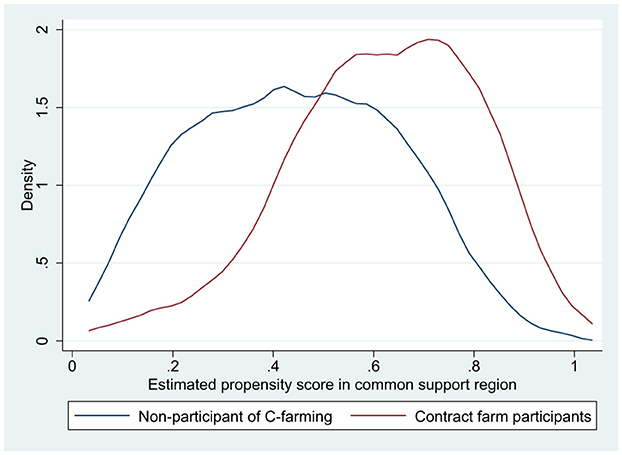
Figure 2. Kernel density of non–contract farmer participant and participant households in the common support region.
4.4.2.3 Testing matching quality/effect estimation
Approximately 36% (5) PS estimates were significant before matching, but all turned out insignificant after matching. The reduction in the mean SB between the matched and unmatched respondents and equality of means for participant and non-participant households tested using t-test were considered for determining the estimator's balancing efficiency. Before matching, the absolute value of the mean of SB ranged from 0.6% to 54.6%; after matching, this value reduced from 16 to 0, with five covariates (35.71%) being significant. Similarly, all covariates became non-significant after matching, while the pseudo-R2 reduced from 0.136 to 0.015, with all t-test values non-significant after balancing in the model (Table 7).
4.4.2.4 Estimation of the ATT groups
The impact of malt barley CF participation on several household outcome variables is shown in Table 8. Impacts were computed for malt barley production (kg), productivity per hectare (kg), and total household income (US$), as well as input utilization/intensification (amount of improved malt barley seed, chemical utilization for malt barley in litters, amount of chemical fertilizer in kg, and land allocation for malt barley production). A household's overall income is positively and significantly impacted by their participation in malt barley CF, according to the results. This outcome is in line with the findings of Bezabeh et al. (2020), Seba (2016), emechu et al. (2017), Maertens and Velde (2017), and Dubbert (2019), who found that farmers who took part in CF made noticeably more money. Malt barley CF involvement raises household incomes by US$745 (~36.25%) compared to non-participant households after matching or after adjusting for pre-CF participation disparities (Table 8).
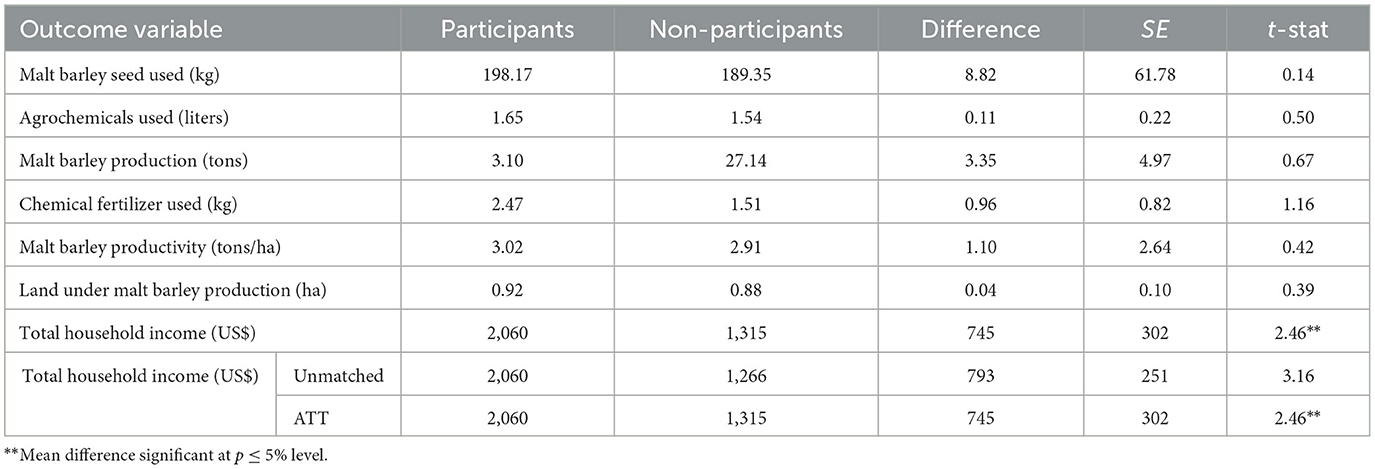
Table 8. The average treatment effect on the treated parameter (ATT) of malt barley contract farming participation on outcome indicator variables.
The overall ATE of malt barley CF participation in the study population is presented in Table 9. The findings align with those reported by Mishra et al. (2016) and Bezabeh et al. (2020), supporting CF's positive impact on smallholder outcomes. The ATE results indicate that CF participation significantly affects three key variables: the amount of fertilizer applied, total household income, and malt barley production per household. Specifically, participation in CF leads to an increase of 2.95 kg in fertilizer application (significant at the 10% level), an increase of US$470.87 in total household income (significant at the 1% level), and a 0.63-ton increase in malt barley production per household (significant at the 5% level). These results suggest that participating in malt barley CF has a substantial positive impact on household welfare, particularly through increased income, as well as improved input use and productivity. The findings underscore the potential of CF as a mechanism for enhancing agricultural intensification and livelihood outcomes for smallholder farmers.
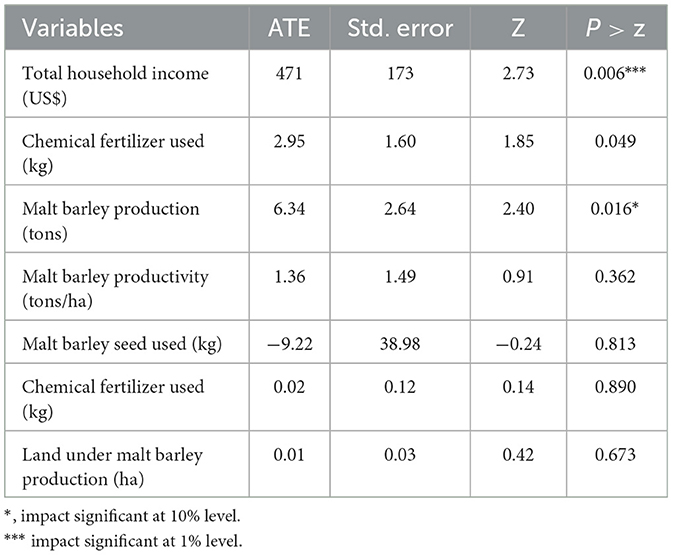
Table 9. Average treatment effects (ATEs) of participation in malt barley contract farming for the population under consideration.
4.4.2.5 Sensitivity analysis
The sensitivity of the ATT estimates to unobserved heterogeneity or hidden bias. In the PSM technique, the selection for treatment is only based on observed characteristics, and it does not control for hidden bias due to unobserved factors (Caliendo and Kopeinig, 2008). Heterogeneity may arise when contract and non-contract farmers differ on unobserved variables that simultaneously influence assignment to treatment and the outcome variable. We checked this using the bounding approach (Rosenbaum and Rosenbaum, 2002). This method relies on the sensitivity parameter gamma (log-odds ratio) that determines how strong an unobservable variable must be to influence the selection process to bias the results (Diprete and Gangl, 2004). Following Diprete and Gangl (2004) and Girma and Gardebroek (2015), we consider various critical gamma value levels. We reported the results of mhbound tests in Table 10. In a hidden bias–free study, that is, where Γ = 1, the QMH test statistic is 1.97 and would constitute strong evidence that participating in malt barley CF results in an increased total household income. The result shows that the assumption that we have overestimated the treatment effect, that is, , or underestimated the treatment effect, that is, , is robust only at selection bias-free assumption (Table 10).
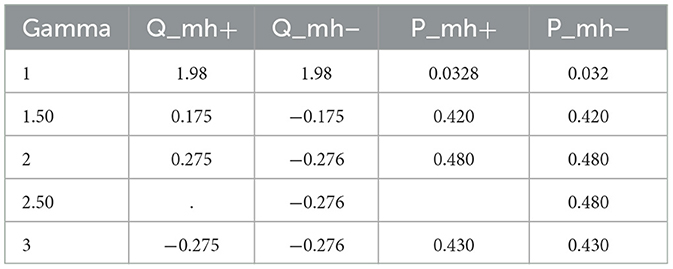
Table 10. Mantel and Haenszel (1959) mhbounds sensitivity analysis.
As the Γ-value deviates from 1, the result becomes insignificant. However, according to Becker and Caliendo (2007), this test cannot directly justify the unconfoundedness assumption. Hence, we cannot state whether the conditional independence assumption does (not) hold for the given setting (including among others the used data, the chosen covariates, and the specification of the PS). However, the results are sensitive to possible deviations from the identifying unconfoundedness assumption; hence, further study may be needed to justify the impact of participation in malt barley CF.
5 Conclusion and recommendations
5.1 Summary and conclusion
The study was conducted in selected highland districts of the Arsi and West Arsi zones, specifically in Kofele and Dodola districts from West Arsi and Lemu-Bilbilo and Digelu-Tijo districts from the Arsi zone. Two sample PAs were selected from each district, resulting in a total sample of 248 households. Of these, 52% were participants in malt barley CF schemes, while 48% were non-participants. Among the CF models adopted in the study area, the intermediary contract and resource-providing contract types are the most prevalent. The majority of farmers involved in CF schemes operate under the intermediary model facilitated by Assela Malt Factory. In contrast, Soufflet Malt, a relatively new entrant to Ethiopia's malting industry, is less established in the study area. Soufflet Malt engages in direct contractual agreements with farmers through local model farmers, with payments made directly to farmers in cash. As a result, participating farmers have expressed a higher level of comfort and satisfaction with this arrangement compared to the intermediary model.
Household educational background, engagement in off-farm and non-farm activities, participation in cooperative-based crop output marketing, involvement in participatory technology demonstration and evaluation of malt barley, and the size of land allocated to malt barley production all significantly and positively influence participation in CF practices for malt barley. The PSM analysis reveals that participating in malt barley CF practices has a significant positive impact on total household income. Specifically, the ATT indicates that households engaged in CF apply 2.95 kg more fertilizer to malt barley, achieve an increase of US$470.87 in income, and produce 0.63 tons more malt barley, compared to non-participating households. Furthermore, the newly introduced malt barley varieties, “Traveler” and “Misicals,” have demonstrated strong performance and are preferred by farmers even for household consumption. These varieties are increasingly replacing traditional food barley in areas with favorable market access, highlighting their competitiveness and market acceptance.
According to findings from the FGDs and descriptive analysis, the most significant advantage of CF is its role in facilitating access to key malt barley production inputs, such as improved seed, weedicides, and chemical fertilizers, often provided on a credit basis. Additionally, CF arrangements ensure market access with a predetermined premium price of 15% above the prevailing market rate. Even when inputs are provided on a cash basis, CF participants still have prioritized access. Overall, farmers are primarily motivated to participate in the malt barley CF scheme due to the security it offers in accessing improved seeds in a timely manner and on credit, which positively influences the volume of malt barley produced.
5.2 Recommendations
The results clearly indicate that CF has a positive impact on household welfare (measured by income), the quantity of malt barley produced, and the amount of fertilizer applied to malt barley. Therefore, expanding CF practices to include currently non-participating farmers holds significant potential for enhancing agricultural productivity and intensification. To encourage greater farmer participation, awareness creation by involving farmers in technology evaluation activities, as well as promoting household membership in cooperatives, can be effective strategies. Additionally, expanding access to informal education can further strengthen farmers' engagement in CF. Notably, the resource-provision CF model, whereby promoters supply key inputs such as improved seeds, fertilizers, and agrochemicals on a credit basis, is the most preferred by farmers. As such, agribusinesses currently employing intermediary CF models are encouraged to transition toward resource-provision models to better align with farmers' preferences and improve the effectiveness of CF schemes.
Expanding CF practices to include more farmers in existing areas, as well as extending to new districts where malt barley production has recently been introduced, is crucial for both parties involved, farmers and breweries/malt factories. However, there are challenges, particularly concerning the timing of sales. Farmers often feel pressured to sell their produce immediately after harvest, during peak production season when supply is high and prices are low, primarily to repay input loans provided by their promoters. It is important that farmers be given the flexibility to decide when to sell their barley, allowing them to wait until prices are reasonable enough to cover production costs and yield a fair profit.
Increasing the number of farmers participating in the CF scheme can expand market opportunities and encourage a shift from food barley to malt barley cultivation, as malt barley is preferred both for consumption and market purposes. By collaborating with farmers and other stakeholders to bring more farmers under the CF arrangement, breweries and malt mills can boost malt barley production, thereby meeting domestic demand more effectively. Achieving this will require substantial financial and technical investment from breweries and factories. Meanwhile, government agencies, particularly the extension services, should act as facilitators to build trust and effective communication between contractual parties.
Because this study does not cover all dimensions of CF's impact, future research should investigate areas such as CF's effects on food security and commercialization levels. Additionally, the study's limited focus on farm income and its reliance on a specific econometric model represent limitations that should be addressed in subsequent research.
Data availability statement
The raw data supporting the conclusions of this article will be made available by the authors, without undue reservation.
Ethics statement
Written informed consent was not obtained from the individual(s) for the publication of any potentially identifiable images or data included in this article because participants provided consent during data collection.
Author contributions
TC: Conceptualization, Data curation, Formal analysis, Funding acquisition, Investigation, Methodology, Project administration, Resources, Software, Supervision, Validation, Visualization, Writing – original draft, Writing – review & editing. EB: Supervision, Validation, Writing – review & editing. ID: Data curation, Supervision, Validation, Writing – review & editing. EF: Writing – review & editing, Methodology, Validation, Visualization.
Funding
The author(s) declare that no financial support was received for the research and/or publication of this article.
Conflict of interest
The authors declare that the research was conducted in the absence of any commercial or financial relationships that could be construed as a potential conflict of interest.
Publisher's note
All claims expressed in this article are solely those of the authors and do not necessarily represent those of their affiliated organizations, or those of the publisher, the editors and the reviewers. Any product that may be evaluated in this article, or claim that may be made by its manufacturer, is not guaranteed or endorsed by the publisher.
References
Abebe, S., and Abebe, L. (2021). Cluster-based improved malt barley technology demonstration in selected districts of Arsi and West Arsi zones of Oromia Regional State, Ethiopia. Open J. Plant Sci. 6, 82–86. doi: 10.17352/ojps.000037
Alemu, D., Kelemu, K., Lakew, B., and Kelemework, F. (2014). Value Chain Analysis of Malt Barley in Arsi and West Arsi Zones of Oromia Region. Addis Ababa: Self Help Africa.
AtlasBig.com (2022). Top barley producing countries. Available online at: https://www.atlasbig.com/en-us/countries-barley-production (Accessed October 28, 2022).
Barrett, C. B., Bachke, M. E., Bellemare, M. F., Michelson, H. C., Narayanan, S., Walker, T. F., et al. (2010). Smallholder participation in agricultural value chains: comparative evidence from three continents. Available online at: http://ssrn.com/abstract=1733942 (Accessed June 27, 2025).
Becker, S. O., and Caliendo, M. (2007). Sensitivity analysis for average treatment effects. Stata J. 7, 71–83. doi: 10.1177/1536867X0700700104
Bezabeh, A., Beyene, F., Haji, J., and Lemma, T. (2020). Impact of contract farming on income of smallholder malt barley farmers in Arsi and West Arsi zones of Oromia region, Ethiopia. Cogent Food Agric. 6:1834662. doi: 10.1080/23311932.2020.1834662
Bijman, J. (2008). Contract Farming in Developing Countries: An Overview; Working Paper. Wageningen: Wageningen University.
BOFED (2012). The national regional government of oromia, bureau of finance and economic development-regional statistics. Available online at: http://www.oromiabofed.org/ (Accessed July 20, 2020).
Briones, R. M., and Galang, I. M. R. (2014). Linking Small Farmers to Modern Markets: The Role of Contract Farming. PIDS Policy Notes. Pilipinas: Surian samgaPag-aaral Pangkaunlaranng.
Caliendo, M., and Kopeinig, S. (2005). Some Practical Guidance for the Implementation of Propensity Score Matching. IZA Discussion Paper Series, No. 1588, Bonn, Germany. doi: 10.2139/ssrn.721907
Caliendo, M., and Kopeinig, S. (2008). Some practical guidance for the implementation of propensity score matching. J. Econ. Surv. 22, 31–72. doi: 10.1111/j.1467-6419.2007.00527.x
Chasukwa, M. (2013). An Investigation of the Political Economy of Land Grabs in Malawi. The Case of Kasinthula Cane Growers Limited (KCGL). Foreign, Commonwealth & Development Office.
Cotula, L., Vermeulen, S., Leonard, R., and Keeley, J. (2009). Land Grab or Development Opportunity?: Agricultural Investments and International Land Deals in Africa. London: IIED.
CSA (Central Statistics Agency) (2015). Agricultural Sample Survey 2014/15. Volume I Report on Area and Production of Major Crops (Private Peasant Holdings, Meher Season), Central Statistical Agency (CSA), Addis Ababa, Ethiopia, 125.
CSA (The Federal Democratic Republic of Ethiopia Central Statistical Agency) (2021). Agricultural Sample Survey 2020/21 (2013 E.C.) Volume I Report on Area And Production Of Major Crops (Private Peasant Holdings, Meher Season). Addis Ababa: Statistical Bulletin No. 590.
CSA (The Federal Democratic Republic of Ethiopia Central Statistical Agency) (2014a). Agricultural Sample Survey 2013/14 (2007 E.C.) Volume I Report on Area and Production of Major Crops (Private Peasant Holdings, Meher Season). Addis Ababa: Statistical Bulletin.
CSA (The Federal Democratic Republic of Ethiopia Central Statistical Agency) (2014b). Agricultural Sample Survey 2014/15 (2008 E.C.) Volume I Report on Area and Production of Major Crops (Private Peasant Holdings, Meher Season). Statistical Bulletin, Addis Ababa.
Dagnew, A., Goshu, D., Zemedu, L., and Sileshi, M. (2023). Impacts of contract farming on asset accumulation of malt barley farmers in Northwestern Ethiopia. Cogent. Econ. Finance 11:2230724. doi: 10.1080/23322039.2023.2230724
Debela, B. L., Ruml, A., and Qaim, M. (2022). Effects of contract farming on diets and nutrition in Ghana. Appl. Econ. Perspect. Policy 44, 911–929. doi: 10.1002/aepp.13204
Dehejia, R. H., and Wahba, S. (2002). Propensity score-matching methods for non-experimental causal studies. Rev. Econ. Stat. 84, 151–161. doi: 10.1162/003465302317331982
Deininger, K., and Byerlee, D. (2011). Rising Global Interest in Farmland: Can it Yield Sustainable and Equitable Benefits?. World Bank Publications. Agriculture and rural development Washington, DC: World Bank. doi: 10.1596/978-0-8213-8591-3
Diprete, T. A., and Gangl, M. (2004). Assessing Bias in the estimation of causal effects: rosenbaum bounds on matching estimators and instrumental variables estimation with imperfect instruments. Soc. Meth. 34, 271–310. doi: 10.1111/j.0081-1750.2004.00154.x
Dubbert, C. (2019). Participation in contract farming and farm performance: insights from cashew farmers in Ghana. Agric. Econ. 50, 1–15. doi: 10.1111/agec.12522
Eaton, C., and Shepherd, A. W. (2001). Contract Farming - Partnerships for Growth: A Guide. Rome: FAO [Food and Agriculture Organization of the United Nations] Agricultural Services Bulletin 145.
EIDP (Ethio-Italian Development Project) (2002). Atlas of Arsi Zone. Assela, Ethiopia: Arsi Agricultural and Rural Development Bureau.
emechu, M., Jema, H., Belaineh, L., and Mengistu, K. (2017). Impact of participation in vegetables' contract farming on household's income in the central rift valley of Ethiopia. Am. J. Rural Dev. 5, 90–96. doi: 10.12691/ajrd-5-4-1
Flores, M., and Holtland, G. (2017). Contract Farming in Ethiopia: Concept and Practice. Arnhem: AgriProFocus.
Ganewo, Z., Balguda, T., Alemu, A., Mulugeta, M., Legesse, T., Kaske, D., et al. (2022). Are smallholder farmers benefiting from malt barley contract farming engagement in Ethiopia?. Agric. Food Secur. 11:58. doi: 10.1186/s40066-022-00396-z
Gebremariam, H. (1992). Availability and Use of Seed in Ethiopia. Addis Ababa: Program Support Unit, Canadian International Development Agency (CIDA). G
Girma, J., and Gardebroek, C. (2015). The impact of contracts on organic honey producers' incomes in southwestern Ethiopia. Forest Policy Econ. 50, 259–268. doi: 10.1016/j.forpol.2014.08.001
Glover, D., and Kusterer, K. (2016). Small Farmers, Big Business: Contract Farming and Rural Development. New York, NY: Springer.
Keele, L. (2010). An Overview of Rbounds: An R package for Rosenbaum Bounds Sensitivity Analysis with Matched Data. Columbus, OH: White Paper.
Key, N., and Runsten, D. (1999). Contract farming, smallholders, and rural development in Latin America: the organization of agroprocessing firms and the scale of outgrower production. World Dev. 27, 381–401. doi: 10.1016/S0305-750X(98)00144-2
Khalfan, M. (2012). Linking smallholders with trans-national agribusiness through contract farming: pro-poor growth or dependency?: a gender-differentiated study of equity, poverty and food security outcomes in Tanzanian peasant communities (thesis). Saint Mary's University, Halifax, NS, Canada.
Kiwanuka, R. N., and Machethe, C. (2016). Determinants of smallholder farmers' participation in Zambian dairy sector's interlocked contractual arrangements. J. Sustain. Dev. 9, 230–245. doi: 10.5539/jsd.v9n2p230
Lechner, M. (2002). Some practical issues in the evaluation of heterogeneous labour market programmes by matching methods. J. R. Stat. Soc. Ser. A. Stat. Soc. 165, 59–82. doi: 10.1111/1467-985X.0asp2
Maertens, M., and Velde, K. V. (2017). Contract-farming in staple food chains: the case of rice in Benin. World Dev. 95, 73–87. doi: 10.1016/j.worlddev.2017.02.011
Mantel, N., and Haenszel, W. (1959). Statistical aspects of the analysis of data from retrospective studies of disease. J. Natl. Cancer Inst. 22, 719–748. doi: 10.1093/jnci/22.4.719
Melese, A. T. (2010). Contract Farming in Ethiopia. Wagenigen: Development Cooperation Wagenigen UR.
Minot, N., and Sawyer, B. (2016). “Contract farming in developing countries: theory, practice, and policy implications,” in Innovation for Inclusive Value-Chain Development: Successes and Challenges, Chapter 4, eds. A. Devaux, M. Torero, J. Donovan, D. Horton (Washington, DC: International Food Policy Research Institute (IFPRI)), 127–158. doi: 10.2499/9780896292130_04
Mishra, A. K., Kumar, A., Joshi, P. K., and D'souza, A. (2016). Impact of contracts in high yielding varieties seed production on profits and yield: the case of Nepal. Food Policy 62, 110–121. doi: 10.1016/j.foodpol.2016.05.005
Mulugeta, T., and Hundie, B. (2012). “Impacts of adoption of improved wheat technologies on households' food consumption in southeastern Ethiopia,” in 2012 Conference, August 18–24, 2012, Foz do Iguacu, Brazil (International Association of Agricultural Economists).
Nazifi, B., and Hussain, Y. I. (2021). Determinants of participation in contract farming among small holder maize farmers in North-Western Nigeria. Acta Sci. Polonorum. Agric. 20, 147–160. doi: 10.37660/aspagr.2021.20.4.2
Ncube, D. (2020). The importance of contract farming to small-scale farmers in Africa and the implications for policy: a review scenario. Open Agric. J. 14, 59–86. doi: 10.2174/1874331502014010059
Nigussie, A., Bekele, T., Fekadu Gemede, H., and Zewdu Woldegiorgis, A. (2018). Level of aflatoxins in industrially brewed local and imported beers collected from Ethiopia market. Cogent Food Agric. 4:1453317. doi: 10.1080/23311932.2018.1453317
Ochieng, C. M. O. (2009). “The political economy of contract farming in tea in Kenya: the Kenya tea development agency (KTDA), 1964–2002,” in The Comparative Political Economy of Development (New York, NY: Routledge), 162–183. doi: 10.4324/9780203861332-17
Olounlade, O. A., Li, G. C., Kokoye, S. E. H., Dossouhoui, F. V., Akpa, K. A. A., Anshiso, D., et al. (2020). Impact of participation in contract farming on smallholder farmers' income and food security in rural Benin: PSM and LATE parameter combined. Sustainability 12:901. doi: 10.3390/su12030901
Otsuka, K., Nakano, Y., and Takahashi, K. (2016). Contract farming in developed and developing countries. Ann. Rev. Resour. Econo. 8, 353–376. doi: 10.1146/annurev-resource-100815-095459
Oya, C. (2012). Contract farming in sub-Saharan Africa: a survey of approaches, debates and issues. J. Agrar. Change 12, 1–33. doi: 10.1111/j.1471-0366.2011.00337.x
Pradhan, M., and Rawlings, L. B. (2002). The impact and targeting of social infrastructure investments: lessons from the Nicaraguan Social Fund. World Bank Econ. Rev. 16, 275–295. doi: 10.1093/wber/16.2.275
Prowse, M. (2012). Contract Farming in Developing Countries: A Review. (A savoir; Vol. 12). Paris: AFD, Agence. française de développement.
Pultrone, C., and Silva, C. A. (2012). Guiding Principles for Responsible Contract Farming Operations. Rome: Rural Infrastructure and Agro-Industries Division, Food and Agriculture Organization of the United Nations.
Rashid, S., Abate, G. T., Lemma, S., Warner, J., Kasa, L., Minot, N., et al. (2019). The barley value chain in Ethiopia. Gates Open Res. 3:169.
Ray, N., Clarke, G., and Waley, P. (2021). The impact of contract farming on the welfare and livelihoods of farmers: a village case study from West Bengal. J. Rural Stud. 86, 127–135. doi: 10.1016/j.jrurstud.2021.06.003
Rehber, E. (2018). Contract farming in practice: an overview. Outlook Agric. 33, 85–93. doi: 10.5367/000000004773973064
Rosenbaum, P. R., and Rosenbaum, P. R. (2002). Overt Bias in Observational Studies. New York: Springer. 71–104. doi: 10.1007/978-1-4757-3692-2_3
Rosenbaum, P. R., and Rubin, D. B. (1983). The central role of the propensity score in observational studies for causal effects. Biometrika 70, 41–55. doi: 10.1093/biomet/70.1.41
Rosenbaum, P. R., and Rubin, D. B. (1985). Constructing a control group using multivariate matched sampling methods that incorporate the propensity score. Am. Stat. 39, 33–38. doi: 10.1080/00031305.1985.10479383
Seba, S. T. (2016). Impact of contract farming on smallholders in Ethiopia: the case of chickpea growers (doctoral dissertation). Lincoln University.
Setboonsarng, S. (2008). Global Partnership in Poverty Reduction: Contract Farming and Regional Cooperation. Tokyo: ADB Institute Discussion Paper No. 89.
Streiner, D. L., and Norman, G. R. (2012). The pros and cons of propensity scores. Chest 142, 1380–1382. doi: 10.1378/chest.12-1920
Suresh, K. P., and Chandrashekara, S. (2012). Sample size estimation and power analysis for clinical research studies. J. Hum. Reprod. Sci. 5, 7–13. doi: 10.4103/0974-1208.97779
Tefera, D. A., and Bijman, J. (2021). Economics of contracts in African food systems: evidence from the malt barley sector in Ethiopia. Agric. Food Econ. 9, 1–21. doi: 10.1186/s40100-021-00198-0
Tolemariam, A. (2010). Impact assessment of input and output market development interventions by IPMS Project: The case of Gomma Woreda, Jimma Zone (MSc Thesis). Haramaya University, Ethiopia.
van Gent, R. (n.d). Contract Farming [PowerPoint slides]. SlidePlayer. Available online at: https://slideplayer.com/slide/1570364/ (Accessed June 27, 2025).
WBG (The World Bank Group) (2018). Case Study: Private Sector Supply Chain Development for Launch of New Ugandan Beer. Washington, DC: License: Creative Commons Attribution CC BY 3.0.
Will, M. (2015). Contract Farming Handbook: A Practical Guide for Linking Small-Scale Producers and Buyers Through Business Model Innovation, Volume II Selected Tools and Case Examples. Bonn: GIZ.
World Agricultural Production (2022). World barley production 2022/2023, September 2022 report. Available online at: http://www.worldagriculturalproduction.com/crops/barley.aspx (Accessed on October 28, 2022).
World Bank (2007). World Development Report 2008: Agriculture for Development. Washington, DC: The World Bank.
Yassin, A. (2014). Transnational large scale agricultural firms in Gambella, Ethiopia: Local potentials, opportunities and constraints for market linkage and contractual farming schemes. Futures agricultures consortium research paper. Available online at: http://www.futureagricultures.org (Accessed December 4, 2017).
Appendix
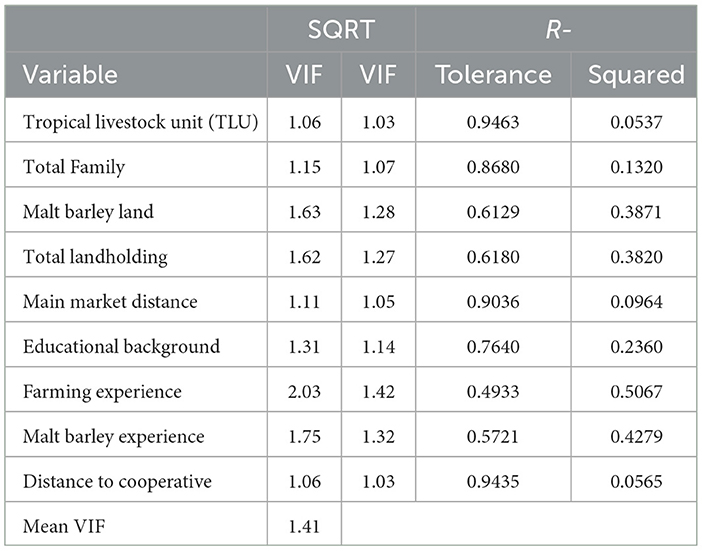
Appendix B. Multicollinearity test results A. Collinearity diagnostics for continuous covariates (variance inflation factor [VIF]).
Keywords: contract farming, malt barley, propensity score matching, intensification, treatment effects
Citation: Challa TG, Boka Dube E, Dawid I and Fathelrahman E (2025) Impact of contract farming on householders' income, intensification, and land productivity in Ethiopia: evidence from smallholder malt barley producers in the highlands of the Central and Southern Oromia region. Front. Environ. Econ. 4:1415517. doi: 10.3389/frevc.2025.1415517
Received: 10 April 2024; Accepted: 13 June 2025;
Published: 21 July 2025.
Edited by:
Philipp Aerni, School of Management Fribourg (HES-SO), SwitzerlandReviewed by:
Seth Etuah, Kwame Nkrumah University of Science and Technology, GhanaEmmanuel Abokyi, Ghana Institute of Management and Public Administration (GIMPA), Ghana
Copyright © 2025 Challa, Boka Dube, Dawid and Fathelrahman. This is an open-access article distributed under the terms of the Creative Commons Attribution License (CC BY). The use, distribution or reproduction in other forums is permitted, provided the original author(s) and the copyright owner(s) are credited and that the original publication in this journal is cited, in accordance with accepted academic practice. No use, distribution or reproduction is permitted which does not comply with these terms.
*Correspondence: Tamrat Gebiso Challa, Z2ViaXNvY2hhbGxhQGdtYWlsLmNvbQ==
†Present address: Tamrat Gebiso Challa, Department of Integrative Agriculture, College of Agriculture and Veterinary Medicine, United Arab Emirates University (UAEU), Al Ain, United Arab Emirates
 Tamrat Gebiso Challa
Tamrat Gebiso Challa Ephrem Boka Dube1
Ephrem Boka Dube1 Ibsa Dawid
Ibsa Dawid